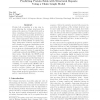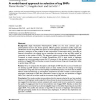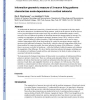439 search results - page 57 / 88 » Maximum entropy methods for biological sequence modeling |
ICML
2005
IEEE
14 years 10 months ago
2005
IEEE
Protein fold recognition is a key step towards inferring the tertiary structures from amino-acid sequences. Complex folds such as those consisting of interacting structural repeat...
BMCBI
2006
13 years 9 months ago
2006
Background: Single Nucleotide Polymorphisms (SNPs) are the most common type of polymorphisms found in the human genome. Effective genetic association studies require the identific...
ALMOB
2006
13 years 9 months ago
2006
Background: Discovering approximately repeated patterns, or motifs, in biological sequences is an important and widely-studied problem in computational molecular biology. Most fre...
JCNS
2011
13 years 4 months ago
2011
To understand the functional connectivity of neural networks, it is important to develop simple and incisive descriptors of multineuronal firing patterns. Analysis at the pairwise...
RECOMB
2006
Springer
14 years 9 months ago
2006
Springer
Computational and comparative analysis of protein-protein interaction (PPI) networks enable understanding of the modular organization of the cell through identification of functio...



